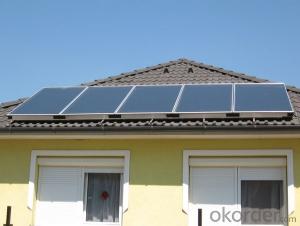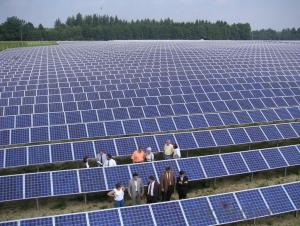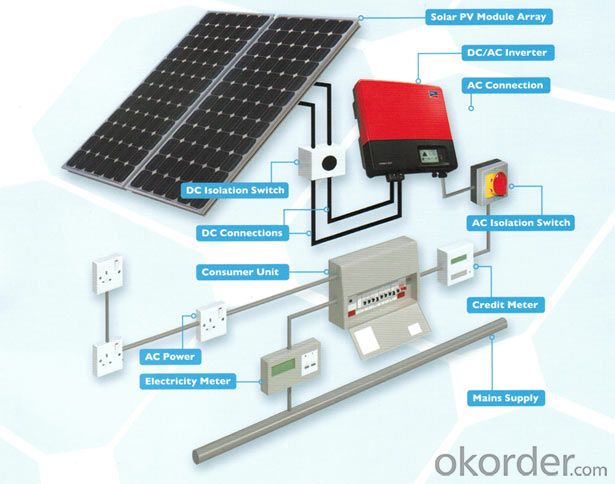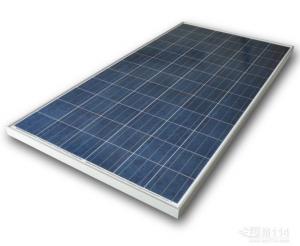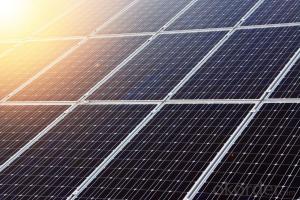Cleco Solar Panels - High Efficiency A Grade Poly Solar Panel 320W Tire One Modules
- Loading Port:
- Shanghai
- Payment Terms:
- TT OR LC
- Min Order Qty:
- 1 watt
- Supply Capability:
- 1000000 watt/month
OKorder Service Pledge
OKorder Financial Service
You Might Also Like
Specification
China National Building Material Group Corporation
CNBM International Corporation is a professional solar panel manufacturer in China for CNBM brand . Silicon panel ( silicon module), as our main product, has high quality and good service. Our products are very popular in Europe, Australia, England, Middle East, Mexico, Argentina, Chili, Singapore and Africa.
As the whole world turns “green”, CNBM enters into the Photovoltaic Industry in 2005.After 6 years' fast growth, now our annual capacity is 500MW solar panel and 500MW solar cell.

Features of our products:
• High conversion efficiency mono/poly-crystalline amorphous silicon solar cells
• Modules incorporate high performance bypass diodes to minimize the power drop caused by shading
• High transmittance, low-iron tempered glass
• High performance EVA encapsulant to prevent destroying and water.
• AI frame: without screw, corner connection. 8 holes on the frame can be installed easily
• Good performance of preventing from atrocious weather such as wind and hails
• Certifications: CE IEC TUV VDE UL, Class I
• 10 years 90% power output warranty
Characteristics of Monocrystalline Silicon Solar Panel
I Solar Cell : High efficiency crystalline solar cell. Even if under the weak light, the solar module can produce maximum power output.
II Tempered glass (toughened glass): Anti-reflecting coating and high transmission rate glass increase the power output and mechanical strength of solar module.
III EVA and TPT: Using high quality EVA and TPT to prevent destroying and water.
IV AI frame: Without screw, corner connection. 6 holes on the frame can be installed easily.
V Junction box: Multi function junction box with water proof.
VI Long lifetime: ≥25 years; Less power decrease.
VII Good performance of preventing from atrocious weather such as wind and hails.
Standard Test Conditions of Monocrystalline Silicon Solar Panel
The opto-electrical specifications shown below are stabilized values being measured at Standard Test Conditions, Irradiance: 1000W/m2, Spectrum: AM1.5 at 25°C, The info below is subject to manufacturing tolerances. Where appropriate minutes of measurement are available and are used for the dimensioning of the installation.
The repair or replacement of the MODULES or the supply of additional MODULES, does not cause the beginning of new warranty terms, nor shall the original terms of this “Limited Warranty for PV-Modules” be extended. Any replaced MODULES shall become the property of CNBM Solar made for their disposal. CNBM Solar has the right to deliver another type ( different in size, color, shape and/or power ) in case CNBM Solar discontinued producing the replaced MODULES at the time of the claim.
The MODULES, including, without limitation, any defects in the MODULES, or from use or installation. Under no circumstances shall CNBM SOLAR be liable for three articles as follows:
1) Client requires compensating the damage caused by above reasons
2) The third party requires client compensating the damage
3)Special, Incidental or indirect damages, or any consequential economic loss (including profit, saving, tax, transportation charge or installing loss etc.), even if CNBM SOLAR has been notified the possibility of happening these damage or loss.
FAQ
We have organized several common questions for our clients,may help you sincerely:
①What price for each watt?
It depends on the quantity, delivery date and payment terms,
②What is your size for each module? Can you tell me the Parameter of your module?
We have different series of panels in different output, both c-Si and a-Si. Please take the specification sheet for your reference.
③Can you provide the peripheral products of the solar panels, such as the battery, controller, and inverter? If so, can you tell me how do they match each other?
Yes, we can, we have two companies for solar region, one is CNBM International, the other is CNBM engineering Co.
We can provide you not only the solar module but also the off grid solar system, we can also provide you service with on grid plant.
④What is your warranty system?
Our product performance guarantees for 25 years
• 12 years guarantee for workmanship
• Timeliness of delivery
• Quality Products certified (TÜV, UL, CE, ISO)
- Q: I've seen a couple homes around my town that have solar power and I live in the Desert, where the sun is shinning and it gets really hot during the summer. We run our air conditioner a lot making our electricity bill high.So I just wanted to know if anyone has or knows anyone that has solar panels? are they worth getting and is it the same as having electricity?
- Our neighbor has solar paneling, and he absolutely LOVES it! It is pretty much the same as having electricity, just better for the environment, and your electricity bill goes down to only about $7 a month!
- Q: can a small solar panel be charged with lamps?
- Sure!...did you ever use a solar powered calculator indoors under a lamp?? It works just fine.
- Q: What is the impact of roof material on solar panels' performance?
- The impact of roof material on solar panels' performance is significant. The type and condition of the roof material can affect the efficiency and effectiveness of solar panels. Certain roof materials, such as metal or asphalt shingles, are more conducive to solar panel installation and can provide a stable and durable surface for the panels. These materials typically allow for better heat dissipation and can withstand the weight of the panels. On the other hand, roofs with clay tiles or slate may require special mounting systems and can be more challenging to install solar panels on. Additionally, a damaged or deteriorating roof can pose a risk to the overall performance and lifespan of the solar panels. Therefore, it is crucial to consider the roof material and its condition when planning for solar panel installation to ensure optimal performance and longevity.
- Q: Can solar panels power an electric car?
- Yes, solar panels can power an electric car. Solar panels generate electricity from sunlight, which can be used to charge the batteries of electric cars. This allows the car to run on clean, renewable energy, reducing the reliance on fossil fuels and providing a sustainable transportation solution.
- Q: I am designing a solar panel but i need to have maximum power output.How can i optimize the equation for power Total power=voltage * current to get maximum power.
- first place the panel so it is at right angles to the solar rays. Make sure none of the panel has any shade whatsoever. For best results use motor drives to keep it in that position as the sun moves across the sky. For overall maximum versus time, you need to be near the equator. Solar cells have a high internal resistance, so for maximum power transfer, you need a load of that same resistance. A good charge controller will use DC-DC converters to provide that load. .
- Q: Can solar panels be used to power a music festival?
- Yes, solar panels can be used to power a music festival. Solar panels generate electricity by converting sunlight into energy, which can be stored in batteries for use during nighttime or cloudy days. By installing a sufficient number of solar panels, a music festival can harness renewable energy to power stages, lighting, sound systems, and other equipment, reducing reliance on traditional power sources and minimizing carbon emissions.
- Q: Hi,I am thinking about getting solar panels installed. # I like to cut my electric bill. #2 I like to eliminate my oil boiler and use some sort of electric boiler.I use about 5000-30000 KW per hour( winter-summer). My oil bill is around 600 month winter time. Over all i pay around 4000 a year. My electric bil now is around 2000-2500 year. Is this possible? I live in NY. I heard you can get up to $35000 rebate from LIPA( Electric company) and 2k from federal and 5k from State( is the state or federal every year?, how does that work). Any help is appreciated.
- There is a variety of information available on the internet regarding solar panels. You didn't say if you were interested in installing a photo-voltaic system to generate electricity, or if you wanted a passive solar system. From what I've read, the method that would give you the greatest payback for your investment is the passive solar heater. I can't give you exact instructions on how to construct one of these units, but there are many websites with instructions. My older brother had one of these mounted on his old farmhouse. He said his furnace didn't run all day during the cold Wisconsin winters. The government rebates or tax credits are usually a one time deal. They may pay for part of your installation, but they won't cover the whole cost. The only thing I've heard of that will pay you every year is a wind generator tied into the electric grid, but thats another posting. I'm including a link to a site that will show you how to build a cheap solar heater that you can try yourself.
- Q: How do solar panels impact the energy independence of a region?
- Solar panels can greatly enhance the energy independence of a region by providing a clean and renewable source of electricity. By harnessing the power of the sun, solar panels reduce the dependence on non-renewable energy sources such as fossil fuels. This reduces the need for importing energy from other regions, thus enhancing the region's energy independence. Additionally, solar panels can be installed on rooftops and other available spaces, allowing individuals and communities to generate their own electricity and become less reliant on the traditional energy grid. Overall, solar panels contribute to a more sustainable and self-sufficient energy future for the region.
- Q: Do I just run the wire from the panel into the charge controller and then to the battery AND can I simultaneously draw energy from the battery while it is being charged by the panel?Is it as simple as hooking it up like that?
- I hope you have some instructions. You need safety switches and fuses in the circuit. What voltage/currents are you running? Don't burn the house down or get electrocuted please. DC can be very dangerous.
- Q: How much energy can a solar panel generate?
- The amount of energy a solar panel can generate depends on various factors such as its size, efficiency, location, and weather conditions. On average, a standard solar panel can generate between 250 to 400 watts of electricity per hour under ideal conditions. However, it's important to note that energy production may vary throughout the day and across different seasons.
Send your message to us
Cleco Solar Panels - High Efficiency A Grade Poly Solar Panel 320W Tire One Modules
- Loading Port:
- Shanghai
- Payment Terms:
- TT OR LC
- Min Order Qty:
- 1 watt
- Supply Capability:
- 1000000 watt/month
OKorder Service Pledge
OKorder Financial Service
Similar products
Hot products
Hot Searches
